PIRMĀ SEMESTRA NOSLĒGUMA TESTI
Read the information about fish, listen and learn some new words.
(Lasi informāciju par zivīm, klausies un mācies jaunos vārdiņus!)
- Seahorse
Seahorses are tiny fish that are named for the shape of their head, which looks like the head of a tiny horse. There are around 36 seahorse species, which are found in tropical and temperate coastal waters where they swim upright among seaweed and other plants. Seahorses’ bodies are covered in tiny, spiny plates, all the way from their head down to their curled, flexible tail. The tail can grasp objects, which comes in handy when these cool critters want to anchor themselves to vegetation. To move forward through the water, seahorses use their back fin. To move up and down, they adjust the volume of air in a tiny pocket inside their body, called a ‘swim bladder’.
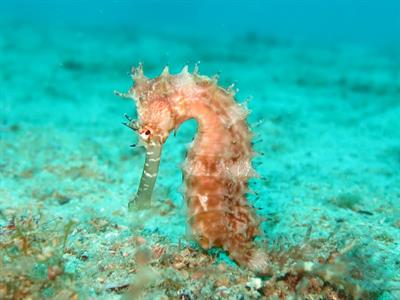
seahorse — [ˈsiː.hɔːs] — jūras zirdziņš
- Shark
The shark is the largest fish in the sea. They have been around for more than 300 million years and were around even before dinosaurs. There are about 350 different types of sharks, but researchers think there are other sharks that haven’t been discovered yet. A shark does not have a single bone in it body, instead it has a skeleton made up of cartilage. Sharks are strong, healthy creatures. No other living thing can take better care of itself than a shark can. Most sharks live for about 25 years, while some can live to be a 100 years too. Most kinds of sharks can swim up to 30 – 60 km per hour. The Mako shark is said to be able to swim at more than 100 miles per hour. A shark’s teeth are usually replaced every eight days. Some species of sharks shed about 30,000 teeth in their lifetime. When a shark loses a tooth, one replaces it. Sharks have very good senses. Sometimes a shark is called “a swimming nose”, for its great sense of smell. Sharks can easily detect prey that is in the sand, as well as at night. A shark also has a remarkable sensitivity to vibrations in the water. It can feel the movements made by other animals that are hundreds of metres away. They can hear sounds from thousands of metres away. The biggest shark is Whale shark that is 12 metres long, but one of the smallest sharks – Pygmy shark is only 28 centimetres long.
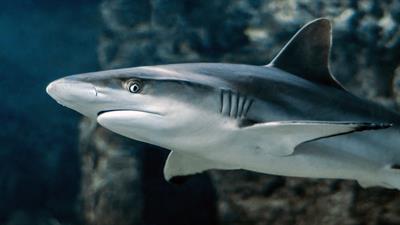
shark— [ʃɑːk] — haizivs
- Stonefish
Stonefish is the most venomous fish in the world. There are 5 species of stonefish that can be found in the coastal regions of Indian and Pacific oceans. Some species of stonefish live in the rivers. Stonefish lives close to coral reefs and underwater rocks. It often lies buried in the sand in the shallow water. Size of stonefish depends on the species. It usually reaches 35 to 50 cm in length and up to 2.5 kg in weight. Body of stonefish is covered with encrusted brown or grey skin, with red, orange or yellow patches. Thanks to specific texture and colour, stonefish easily blends with its environment. Stonefish is a carnivore (meat-eater). Its diet consists of various types of fish and shrimps.
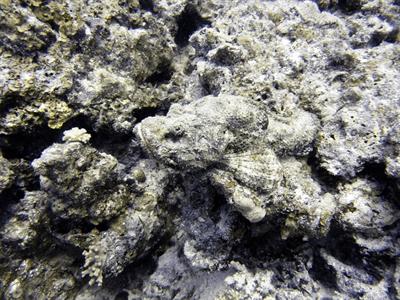
stonefish — [ˈstəʊn.fɪʃ] — akmeņzivs
venomous — [ˈven.ə.məs] — indīgs
- Sturgeon
Sturgeons have been referred to as "living fossils" or "primitive fish" because their features have stayed little changed since their earliest fossil record. The sturgeon is a large bluish-black fish that is very famous for providing caviar. There are a dozen species located in temperate waters in the Northern Hemisphere. The sturgeon spends most of its time in the sea but returns to fresh water to spawn. Sturgeons are slow-moving and spend most of their time searching for food. The taste buds of the sturgeon are on the outside of the mouth. These help in the selection of food. They protrude from a toothless mouth to suck in the food. In fresh water, they eat insect larvae, worms, crayfish, snails, and other small fish. In the sea, their diet consists of mollusks, shrimp, other small crustaceans, worms, and small fish. The sturgeon is a slow feeder and can survive weeks without eating.
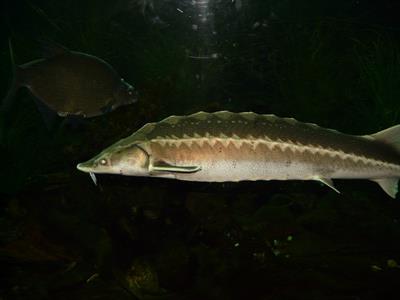
sturgeon — [ˈstɜː.dʒən] — store
- Swordfish
Swordfish are large, highly migratory, predatory fish characterized by a long, flat, pointed bill. Swordfish are elongated, round-bodied, and lose all teeth and scales by adulthood. These fish are found widely in tropical and temperate parts of the Atlantic, Pacific, and Indian Oceans, and can typically be found from near the surface to a depth of 550 m. They commonly reach 3 m in length, and the maximum reported is 4.55 m in length and 650 kg in weight..
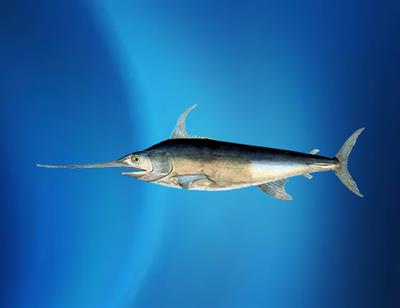
swordfish — [ˈsɔːd.fɪʃ] — zobenzivs
- Trout
Trout is a kind of teleost fish. There are many different kinds of trout. They belong to the same family as the salmon. Most trouts are fresh water fish. They live in clear streams, rivers and lakes in America, Europe, and Asia. There are two main groups of trout species: black-spotted trout and speckled trout. Trout vary in size, depending on the species. Many species of trout are about 30 centimeters long. Trout eat insects, small fishes, and eggs of other fish. Many species spawn, or reproduce, in the spring or the fall. The females bury their eggs in gravel nests that they dig in the bottom of streams. The eggs hatch after two or three months.
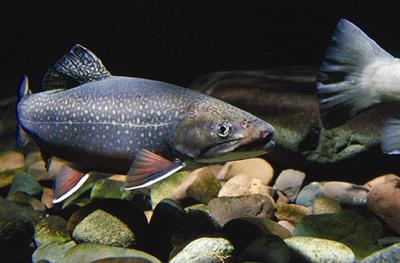
trout — [traʊt] — forele
- Tuna
Tuna are a streamlined silver fish with large eyes, dark blue backs and spiky fins. Tuna are normally between 1-2m in length, they can be very heavy for their size as they have lots of muscle for swimming. Tuna eat small shrimp-like animals called krill, along with larger animals like pilchards and squid. Tuna live in the open ocean which means they don’t just stay in one place and spend a lot of time swimming around, in fact they never stop moving.
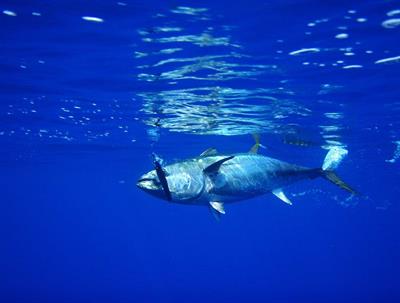
tuna — [ˈtʃuː.nə] — tuncis, tunzivs
Atsauce:
https://kidskonnect.com/animals/shark/
https://www.softschools.com/facts/animals/stonefish_facts/480/
https://answersingenesis.org/kids/fish/sturgeon/
https://kids.kiddle.co/Sturgeon
https://kids.kiddle.co/Swordfish
https://www.natgeokids.com/nz/discover/animals/sea-life/seahorse-facts/
https://fishandkids.msc.org/en/play/fishyfactfiles/tuna